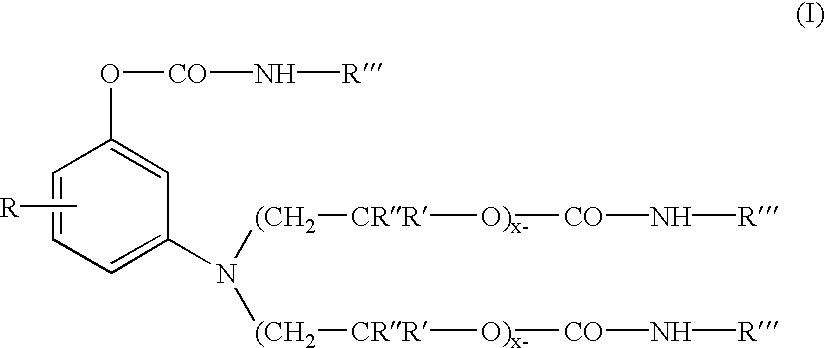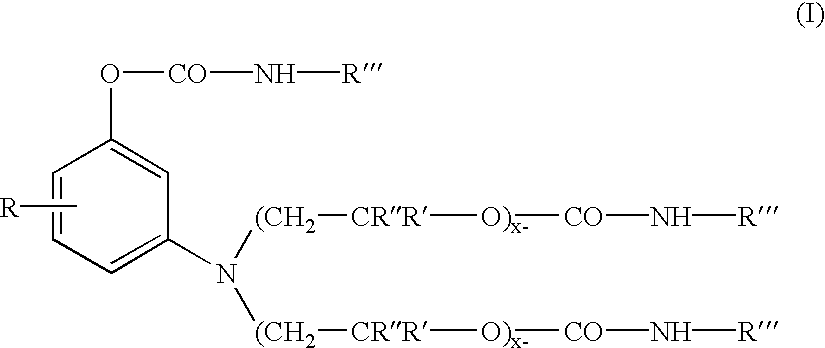Methods of making magenta colorants for ink systems
a colorant and magenta technology, applied in the field of rhodamine dyes, can solve the problems of low-toxicity rhodamine and relatively poor light fastness, limited use, etc., and achieve the effects of low phthalate amount, low hue error, and excellent spectral strength
- Summary
- Abstract
- Description
- Claims
- Application Information
AI Technical Summary
Benefits of technology
Problems solved by technology
Method used
Image
Examples
example 2
193 parts of the polyoxyalkylene substituted aminophenol intermediate precursor of Formula (A) ##STR6##
(from U.S. Pat. No. 5,250,708) were charged into a reactor vessel 168 parts of n-butyl isocyanate, and 13.4 parts of dibutyltindilaurate catalyst. The mixture was heated with stirring to 70.degree. C. under a N.sub.2 atmosphere. After 4.0 hours at 70 C. an FT-IR spectrum of the product was obtained to insure all isocyanate functionality is consumed. The absence (disappearance) of a peak at about 2275 cm.sup.-1 (NCO) and the appearance (or increase in magnitude) of peaks at about 1740-1680 cm.sup.-1 and about 1540-1530 cm.sup.-1 corresponding to urethane frequencies, thereby confirm the conversion of the isocyanate to the urethane.
Colorant Production
The general methods of making the preferred inventive colorants are as follows:
example 3
(Xanthene)
700 parts of the intermediate produced in Example-1 was charged into a flask containing 399 parts of phthalic anhydride, 41.6 parts of 93% sulfuric acid, and 832 parts of toluene (solvent). The reactants were then heated up to 100.degree. C. and maintained at a temperature from about 100 to 105.degree. C., until the 340 nm peak, representing the inventive intermediate, in the uv / vis spectrum has disappeared and the color value, measured as absorbance (550 nm) per gramn per liter, representing the target xanthene colorant stops to increase in magnitude (through measurement by a uv / vis spectrophotometer). The product was washed with deionized water and filtered and the toluene was removed by the azeatrope with water to yield the urethane substituted xanthene, leaving a compound exhibiting a brilliant magenta hue and represented by Formula (11) ##STR7##
wherein R'" is octadecenyl, R" is methyl, R' is hydrogen, X is HSO.sub.4.sup.-, and x=y=1 (thus x+y=2.
Ink Applications
example 4
(Wax Based Inks)
20 parts of the xanthene colorant produced in Example 3 was mixed with a color stick from Xerox for a Phaser 850 printer under heat (120-150.degree. C.). The product was allowed to mix well while hot and poured into an aluminum dish. This mixture was subjected to several heating and cooling cycles to determine compatibility through these cycles. The product appeared to be completely compatible with the wax systems throughout the heating / cooling cycles. After contacting with paper, the colorant exhibiting .DELTA.E* well below 1.5 in accordance with the oven aging test described above.
PUM
 Login to View More
Login to View More Abstract
Description
Claims
Application Information
 Login to View More
Login to View More - R&D
- Intellectual Property
- Life Sciences
- Materials
- Tech Scout
- Unparalleled Data Quality
- Higher Quality Content
- 60% Fewer Hallucinations
Browse by: Latest US Patents, China's latest patents, Technical Efficacy Thesaurus, Application Domain, Technology Topic, Popular Technical Reports.
© 2025 PatSnap. All rights reserved.Legal|Privacy policy|Modern Slavery Act Transparency Statement|Sitemap|About US| Contact US: help@patsnap.com



